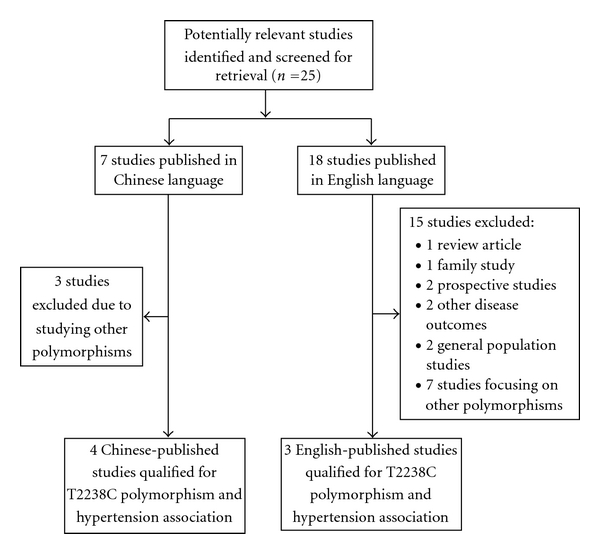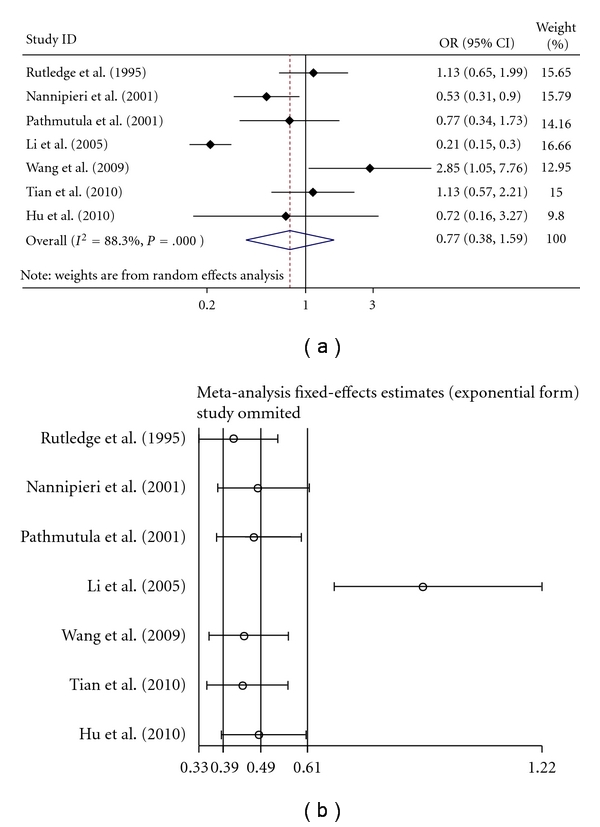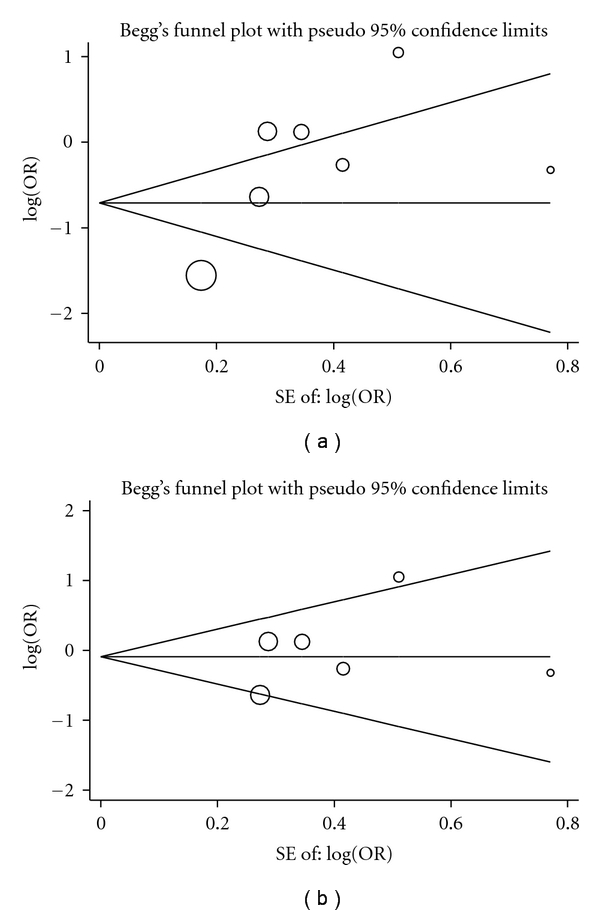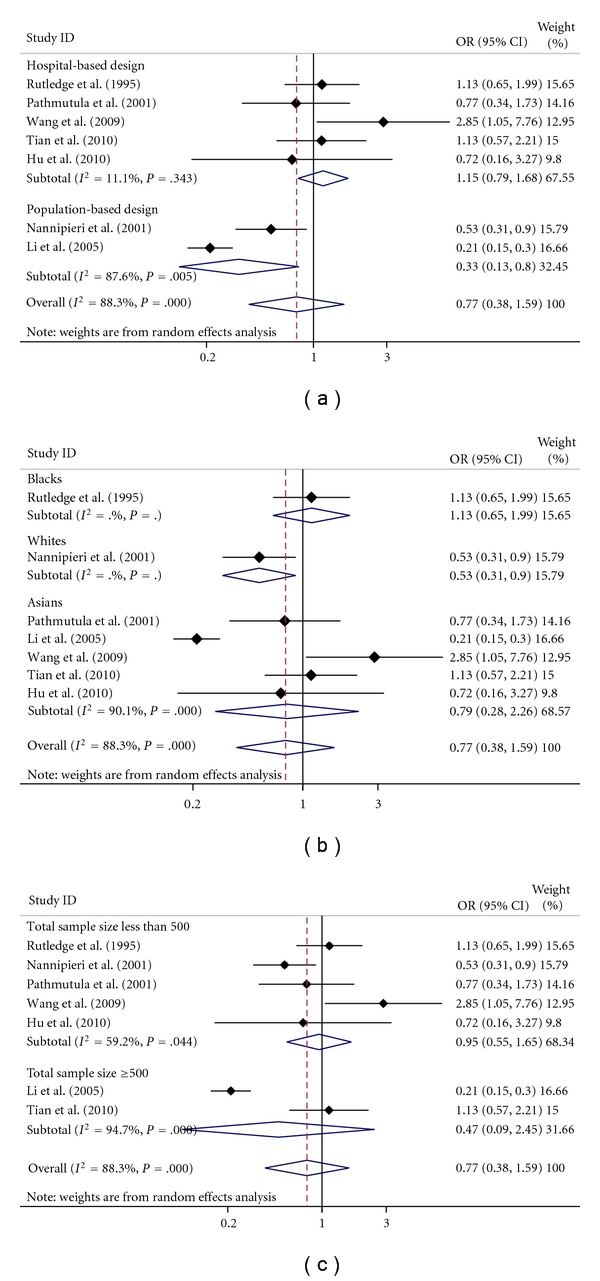Abstract
Single studies attempting to associate ANP gene T2238C (rs5065) polymorphism with hypertension have so far reported inconclusive results. We therefore aimed to evaluate this association via a meta-analysis. Data on 7 studies with a total of 4068 subjects were available and analyzed using the random-effects model with assessment of heterogeneity and publication bias. Overall comparison of 2238C with 2238T yielded a 23% reduced, albeit nonsignificant, risk for hypertension (95% CI: 0.38–1.59; P = .485), while accompanying significant heterogeneity (I2 = 88.3%) and publication bias (P = .051). Subgroup analysis by study design demonstrated opposite associations between population-based (OR = 0.33; 95% CI: 0.13–0.80; P = .015) and hospital-based studies (OR = 1.15; 95% CI: 0.79–1.68; P = .454). Further meta-regression analysis exclusively indicated the significant influence of study design (P = .042) on heterogeneity. Taken together, these findings support the notion that carriers of 2238C allele were at moderate decreased risk of developing hypertension, whereas study design was identified as a potentially significant source of between-study heterogeneity.
1. Introduction
Hypertension is a complex syndrome influenced by multiple genetic and environmental factors [1]. In view of some individuals being more susceptible to hypertension than others, it is essential to explain this interindividual differential susceptibility [2]. Although great hope was expressed in genome-wide association studies to unlock the genetic basis of hypertension, the results from such research, however, have told us little [3]. Given the limited power of single studies, one practicable strategy is to perform large meta-analyses to reliably evaluate the predetermined candidates in genetic association studies.
The gene encoding atrial natriuretic peptide (ANP, chromosome 1p36.21) is a logical candidate for involvement in the underlying cause of hypertension. The candidacy of ANP gene is well defined. Knockout mice deficient in one copy of ANP gene was associated with salt-sensitive hypertension [4]. In contrast, overexpression of ANP gene via gene therapy in hypertensive mice had lowered systolic blood pressure [5]. These findings therefore encourage the search for human genetic polymorphisms that affect the ANP functionality. A large panel of ANP gene polymorphisms have been identified; in particular, an exonic polymorphism T2238C (rs5065) ranks high in association with hypertension; however, the results in some individually underpowered studies are often irreproducible [6, 7]. To derive a more precise estimation, we therefore meta-analyzed the association of ANP gene T2238C polymorphism with occurrence of hypertension from both English and Chinese literature, while addressing between-study heterogeneity and publication bias.
2. Methods
2.1. Search Strategy for Identification of Studies
We searched PubMed and EMBASE, as well as China Biological Medicine (http://sinomed.imicams.ac.cn/index.jsp) and Wanfang (http://www.wanfangdata.com.cn) databases for articles published before 10 February 2011 using the Boolean combinations of keywords (atrial natriuretic peptide OR natriuretic peptide precursor A OR ANP or NPPA) AND (hypertension OR blood pressure) AND (polymorphism OR allele OR genotype OR variant OR variation). Search results were limited to human populations and articles written in both English and Chinese languages. The full text of the retrieved articles was scrutinized to decide whether information on the topic of interest was included. Reference lists of these retrieved articles and systematic reviews were also checked to determine whether citations of articles were not initially identified. For these articles involving more than one geographic or ethnic heterogeneous groups, each group was treated separately.
2.2. Inclusion/Exclusion Criteria
Articles were included in this meta-analysis if they examined the hypothesis that ANP gene T2238C polymorphism was associated with hypertension, if they followed a case-control or cross-sectional study design, and if they provided sufficient information on T2238C genotype counts between hypertensive patients and controls for determining an estimate of odds ratio (OR) and its corresponding 95% confidence interval (CI).
Hypertension was defined as systolic blood pressure equal to or above 140 mmHg or diastolic blood pressure equal to or above 90 mmHg or previous treatment with antihypertensive drugs. Studies evaluating secondary hypertension or other types of monogenic hypertension were excluded. Where there were multiple articles from the same study population, the most complete and recent results were extracted.
2.3. Extracted Information
The following characteristics were extracted independently and entered into separate databases by Wenquan Niu and Yue Qi (who is an assistant researcher in Beijing Institute of Heart, Lung & Blood Vessel Diseases, Anzhen Hospital) from each qualified study: first author's last name, publication date, population ethnicity, study design, diagnostic criteria, baseline characteristics of the study population (such as age, gender, and body mass index), and the T2238C genotype counts in patients and controls. For consistency, quantitative variables expressed as mean ± standard error (SE) were converted to mean ± standard deviation (SD). Any encountered discrepancies were adjudicated by a discussion, and a consensus was reached.
2.4. Statistical Analysis
The random-effects model using the DerSimonian & Laird method was implemented to bring the individual effect-size estimates together, and the estimate of heterogeneity was taken from the Mantel-Haenszel model [13]. Unadjusted OR and 95% CI were used to compare genetic contrasts between patients and controls.
Between-study heterogeneity was assessed by the inconsistency index I2 statistic (ranging from 0 to 100%), which was documented for the percentage of the observed between-study variability due to heterogeneity rather than chance, with higher values suggesting the existence of heterogeneity [14, 15]. In the case of between-study heterogeneity, we examined the study characteristics that can stratify the studies into subgroups with homogeneous effects. In addition, to estimate the extent to which one or more covariates explain heterogeneity, meta-regression, as an extension to random-effects meta-analysis, was employed.
Cumulative meta-analysis was conducted to identify the influence of the first published study on the subsequent publications, and the evolution of the combined estimates over time according to the ascending date of publication. To identify potentially influential studies, sensitivity analysis was undertaken by removing an individual study each time to check whether any of these estimates can bias the overall estimate.
The funnel plots and Egger regression asymmetry test were used to assess publication bias. Egger's test can detect funnel plot asymmetry by determining whether the intercept deviates significantly from zero in a regression of the standardized effect estimates against their precision.
Probability less than 0.05 was judged significant with the exception of the I2 statistic and Egger's test, where a significance level of less than 0.1 was chosen. Data management and statistical analyses were performed using STATA version 11.0 for Windows.
3. Results
3.1. Search Results
Based on our search strategy, the primary screening produced 25 potentially relevant articles, of which 7 met the inclusion criteria with an attempt to evaluate the association of ANP gene T2238C polymorphism with the occurrence of hypertension [6–12]. A total of 2041 hypertensive patients and 2027 controls were analyzed. Of these 7 articles, three [6–8] were published in English and four in Chinese language [9–12]. Five out of 7 articles were conducted in Asians (four in Chinese [9–12] and one in Japanese [8]). The detailed selection process is presented in Figure 1.
Figure 1.

Flow diagram of search strategy and study selection.
3.2. Study Characteristics
The baseline characteristics of qualified studies are presented in Table 1. Overall 2238C allele frequency was 4.19% in patients and 8.14% in controls with the highest frequency noted in an African-American population (41.67% and 38.64%) [6] and the lowest frequency in a Chinese Han population (0.92% and 0.82%) [10]. Genotyping for T2238C polymorphism across all studies, except two using the gene chip technology [9, 12] and one using TaqMan assay [10], was conducted using polymerase chain reaction-restriction fragment length polymorphism (PCR-RFLP) followed by enzyme ScaI digestion.
Table 1.
The baseline characteristics of all qualified studies in this meta-analysis.
| Author, ref and year | Country (Ethnicity) | Design | Status | Age, year | Gender, M (%) | BMI, kg/m2 | SBP, mmHg | DBP, mmHg | T2238C | ||
|---|---|---|---|---|---|---|---|---|---|---|---|
| TT | TC | CC | |||||||||
|
Rahmutula et al. [8] 2001 |
Japan (Japanese) | H-B | Cases | 50 (8) | 65.67 | 24.7 (3.7) | 170 (20) | 105 (12) | 222 | 11 | 0 |
| Controls | 49 (10) | 69.95 | 23 (3.1) | 115 (13) | 70 (10) | 200 | 13 | 0 | |||
|
Nannipier et al. [7] 2001 |
Europe (White) | P-B | Cases | 56 (11) | 47.93 | 25.9 (2.8) | 141 (15) | 86 (10) | 95 | 26 | 0 |
| Controls | 41 (10) | 47.62 | 24.4 (3.2) | 122 (14) | 78 (8) | 67 | 37 | 1 | |||
|
Rutledge et al. [6] 1995 |
US (Black) | H-B | Cases | 44.7 (15.2) | 56.70 | —* | — | — | 17 | 36 | 7 |
| Controls | 44.8 (14.7) | 65.90 | — | — | — | 19 | 16 | 9 | |||
|
Hu et al. [9] 2010 |
China (Han Chinese) | H-B | Cases | 57.71 (9.97) | 48 | 23.79 (2.99) | 171.47 (13.01) | 100.74 (8.34) | 97 | 3 | 0 |
| Controls | 55.05 (10.64) | 43.30 | 24.24 (4.50) | 115.66 (10.99) | 73.49 (8.15) | 93 | 4 | 0 | |||
|
Tian and Cheng [10] 2010 |
China (Han Chinese) | H-B | Cases | 59.89 (9.81) | 72.00 | 24.33 (3.69) | 170.95 (23.86) | 105.67 (14.35) | 960 | 14 | 2 |
| Controls | 59.68 (9.78) | 70.00 | 23.31 (3.21) | 115.59 (20.85) | 70.20 (11.00) | 962 | 12 | 2 | |||
|
Li et al. [11] 2005 |
China (Kazakh Chinese) | P-B | Cases | 46.80 (7.82) | 40.89 | 26.27 (4.84) | 168.53 (24.72) | 104.51 (15.02) | 273 | 35 | 5 |
| Controls | 45.75 (8.63) | 45.37 | 25.16 (5.63) | 117.39 (11.36) | 73.95 (8.58) | 205 | 187 | 16 | |||
|
Wang and Mao [12] 2009 |
China (Han Chinese) | H-B | Cases | 68.61 (12.76) | 57.14 | — | — | — | 220 | 18 | 0 |
| Controls | 68.45 (13.19) | 59.27 | — | — | — | 179 | 5 | 0 | |||
Ref: reference number; P-B: population-based design; H-B: hospital-based design; M (%): male (percent); BMI: body mass index; SBP: systolic blood pressure; DBP: diastolic blood pressure. *Information not available. Data are expressed as mean (SD) unless otherwise indicated.
3.3. Overall Analysis
Considering the low frequency of 2238CC genotype, we only assessed the association of 2238C allele (relative to 2238T allele) with hypertension risk in this meta-analysis. Overall speaking, comparison of allele 2238C with 2238T generated a 23% reduced, albeit nonsignificant, risk for hypertension (95% CI: 0.38–1.59; P = .485) (Figure 2). Meanwhile, there was strong evidence of between-study heterogeneity (I2 = 88.3%, P < .0005) and high possibility of publication bias as reflected by the suggestive asymmetry of funnel plot (Figure 3) and the Egger's test (P = .051).
Figure 2.

Overall risk estimate of ANP gene 2238C versus 2238T allele for hypertension (a) and the presentation of its influential analysis (b).
Figure 3.

Funnel plots for studies investigating the effect of ANP gene T2238C polymorphism on the risk of hypertension in overall allelic model (a) and after excluding the most influential study (b). Vertical axis represents the log of OR; horizontal axis represents the SE of log(OR). Funnel plots are drawn with 95% confidence limits. OR, odds ratio; SE, standard error. The graphic symbols represent the data in the plot sized proportional to the inverse variance.
3.4. Cumulative and Influential Analyses
In the cumulative meta-analysis, there was no evidence suggesting the first published study that reported a potentially significant result and then trigged the subsequent replication (data not shown). However, the influential analysis revealed that there was one study in a Kazakh Chinese population [11] influencing the overall results significantly (Figure 2). When this most influential study was removed, the overall estimate was strongly attenuated with OR approaching the unity (OR = 0.97; 95% CI: 0.62–1.51; P = .897). Likewise, between-study heterogeneity was remarkably reduced (I2 = 51.2%, P = .069), and there was a low probability of publication bias (P = .479) (Figure 3).
3.5. Subgroup Analysis
Considering the significance of heterogeneity, we considered as a better choice to try investigating its sources by conducting subgroup analysis in characteristic-homogeneous groups. To evaluate the possible effect of study design on the variability of overall estimates, studies were divided into population-based and hospital-based studies, and importantly the magnitude of association in population-based studies was strikingly reinforced with the 2238C allele conferring a significant protective effect on hypertension (OR = 0.33; 95% CI: 0.13–0.80; P = .015), whereas this effect was reversed in hospital-based studies with no attainable significance (OR = 1.15; 95% CI: 0.79–1.68; P = .454) (Figure 4(a)).
Figure 4.

Subgroup analysis of ANP gene T2238C polymorphism with hypertension by study design (a), ethnicity (b), and sample size (cutoff: 500 individuals) (c) in the allelic model.
Further subgroup analysis by ethnicity suggested heterogeneous associations of T2238C polymorphism with hypertension, by showing a suggestive risk effect of 2238C allele in Blacks (OR = 1.13; P = .66), a significant protective effect in Whites (OR = 0.53; P = .019), and a moderate protective effect in Asians (OR = 0.79; P = .663) (Figure 4(b)).
Because sample size of study is also a major factor affecting the reliability, we therefore used an additional strategy to estimate the effect by grouping only those large association studies with an arbitrary cutoff of 500 individuals. Two out of seven studies had sample sizes greater than 500 and conferred a 53% reduced risk for 2238C allele relative to 2238T allele (95% CI: 0.09–2.45; P = .374), accompanying high between-study heterogeneity (I2 = 94.7%, P < .0005) (Figure 4(c)).
3.6. Meta-Regression Analysis
To further account for between-study heterogeneity within a multivariable framework, we performed meta-regression by incorporating various study-level covariates including averaged levels of age, male percent, and body mass index (BMI) between patients and controls, as well as study design and ethnicity altogether, and we interestingly and exclusively observed that study design was a significant source of between-study heterogeneity (P = .042).
4. Discussion
This study, including 4068 subjects, to our knowledge, is the first meta-analysis examining the relationship between ANP gene T2238C polymorphism and hypertension. Although some statistical biases could not be eliminated, our results suggested that carriers of 2238C allele were at moderate decreased risk of developing hypertension, whereas study design was identified as a potentially significant source of between-study heterogeneity by both subgroup and meta-regression analyses, indicating the robustness of our results.
Genetic heterogeneity is an inevitable problem in any disease identification strategy [16]. As shown in this study, we speculated that ANP gene T2238C polymorphism might have diverse roles in different ethnic populations. On one hand, striking differences were noted in terms of mutant 2238C allele frequency between African-Americans and Asians, with the former almost tenfold higher than the latter, suggesting that different genetic backgrounds may cause this discrepancy, or different populations may have different linkage disequilibrium patterns. A polymorphism may be in close linkage with another nearby causal variant in one ethnic population but not in another [17]. The ANP gene T2238C polymorphism may be in close linkage with different nearby causal variants in different populations. On the other hand, in our subgroup analysis, T2238C polymorphism showed significant heterogeneous associations with hypertension across different ethnic groups, with 2238C allele in African-Americans being completely at odds with that in Whites and Asians, suggesting that this polymorphism might have a multifunctional role in the pathogenesis of hypertension or interact with other genetic and environmental factors. However, considering the relative small sample sizes in each group, we suggest that confirmation in large, well-designed studies is critical.
Besides the disturbing influence of ethnicity in this meta-analysis, it should still be treated with caution because of different study designs. Interestingly, we observed that magnitude of association was reversed in population-based studies relative to in hospital-based studies although no significance was identified for the latter. Regarding this point, we agree that control for population stratification remains an important consideration in hospital-based studies [18], because in this meta-analysis, most studies have recruited subjects from only one hospital, and thus there might be a narrow socioeconomic profile for both patients and controls. Moreover, in hospital-based studies, poor comparability between cases and controls might exert a confounding effect on the true association in light of a regional specialty for the disease under study and the differential hospitalization rates between cases and controls [19]. In contrast, subjects drawn from community or a fixed group might be representative of the true population, leading us to believe that results from population-based studies might hold the water. Considering the wider confidence intervals of estimates and small sample sizes in population-based studies, more studies are required to quantify this effect size reliably.
Despite the clear strengths of our study including relatively large sample sizes and robustness of statistical analyses, interpretation of our current study, however, should be viewed in light of several technical limitations. Because only published studies were retrieved in this meta-analysis and the “grey” literature (articles in languages other than English and Chinese) was not included, publication bias might be possible, even though our funnel plots and statistical tests did not show it. In addition, most studies in this meta-analysis have recruited subjects aged ≥50 years, for whom environmental factors are likely to contribute more prominently than the genetic component to the development of hypertension [20], suggesting that large association studies in a younger population of hypertensive subjects are of added interest. Moreover, the single-locus-based nature of meta-analysis precluded the possibility of gene-gene and gene-environment interactions, as well as haplotype-based effects, suggesting that additional studies assessing these aspects will be necessary. Furthermore, we only centered on ANP gene T2238C polymorphism and did not cover other candidate genes or polymorphisms. It seems likely that the T2238C polymorphism individually makes a moderate contribution to risk prediction in hypertensive subjects, but whether this polymorphism integrated with other risk factors will enhance the prediction requires additional research. Thus, the jury must refrain from drawing a conclusion until large, well-performed studies confirm or refuse our results.
Taken together, we expand previous single studies on hypertension by suggesting that ANP gene T2238C polymorphism might contribute to the occurrence of hypertension, especially in population-based studies. Also our observations leave open the question regarding the heterogeneous effect of 2238C allele across different ethnic populations. Further genetic and functional studies are warranted to elucidate the relationship between T2238C polymorphism and hypertension, and mechanisms of the ANP gene and hypertension.
Acknowledgments
This work was supported by the SMC Excellent Young Faculty Award of Shanghai Jiao Tong University, Youth Foundation of Shanghai Municipal Health Bureau (2010Y050), Shanghai “Chen Guang” Project (09CG12), the Natural Science Foundation of Shanghai (09ZR1426200), and the National Science Foundation for Young Scientists of China (30900808).
References
- 1.Niu W, Wu S, Zhang YI, et al. Validation of genetic association in apelin-AGTRL1 system with hypertension in a larger Han Chinese population. Journal of Hypertension. 2010;28(9):1854–1861. doi: 10.1097/HJH.0b013e32833b1fad. [DOI] [PubMed] [Google Scholar]
- 2.Niu W, Qi Y, Hou S, Zhai X, Zhou W, Qiu C. Haplotype-based association of the renin-angiotensin-aldosterone system genes polymorphisms with essential hypertension among Han Chinese: the Fangshan study. Journal of Hypertension. 2009;27(7):1384–1391. doi: 10.1097/HJH.0b013e32832b7e0d. [DOI] [PubMed] [Google Scholar]
- 3.Kurtz TW. Genome-wide association studies will unlock the genetic basis of hypertension: con side of the argument. Hypertension. 2010;56(6):1021–1025. doi: 10.1161/HYPERTENSIONAHA.110.156190. [DOI] [PubMed] [Google Scholar]
- 4.John SWM, Krege JH, Oliver PM, et al. Genetic decreases in atrial natriuretic peptide and salt-sensitive hypertension. Science. 1995;267(5198):679–681. doi: 10.1126/science.7839143. [DOI] [PubMed] [Google Scholar]
- 5.Schillinger KJ, Tsai SY, Taffet GE, et al. Regulatable atrial natriuretic peptide gene therapy for hypertension. Proceedings of the National Academy of Sciences of the United States of America. 2005;102(39):13789–13794. doi: 10.1073/pnas.0506807102. [DOI] [PMC free article] [PubMed] [Google Scholar]
- 6.Rutledge DR, Sun Y, Ross EA. Polymorphisms within the atrial natriuretic peptide gene in essential hypertension. Journal of Hypertension. 1995;13(9):953–955. doi: 10.1097/00004872-199509000-00003. [DOI] [PubMed] [Google Scholar]
- 7.Nannipieri M, Manganiello M, Pezzatini A, De Bellis A, Seghieri G, Ferrannini E. Polymorphisms in the hANP (human atrial natriuretic peptide) gene, albuminuria, and hypertension. Hypertension. 2001;37(6):1416–1422. doi: 10.1161/01.hyp.37.6.1416. [DOI] [PubMed] [Google Scholar]
- 8.Rahmutula D, Nakayama T, Soma M, et al. Association study between the variants of the human ANP gene and essential hypertension. Hypertension Research. 2001;24(3):291–294. doi: 10.1291/hypres.24.291. [DOI] [PubMed] [Google Scholar]
- 9.Hu D, Shao J, Zhao X, et al. Association between the polymorphisms of candidate gene ANP/NPR-C and essential hypertension. Journal of Medical Research. 2010;39:72–75. [Google Scholar]
- 10.Tian C, Cheng L. Association of polymorphisms in atrial and brain natriuretic peptide gene with essential hypertension. Acta Universitatis Medicinae Tongji. 2010;39:13–17. [Google Scholar]
- 11.Li N, Zhang Y, Li T, Zhou L. The relationship between ANP gene T2238C polymorphism and essential hypertension in Xinjiang Kazakans. Journal of Clinical Cardiology (China) 2005;21:513–515. [Google Scholar]
- 12.Wang Z, Mao YJ. The relationship between endothelial atrial natriuretic peptide and type-C natriuretic peptide receptor gene polymorphisms and essential hypertension in elderly. Journal of Clinical Internal Medicine. 2009;26:620–622. [Google Scholar]
- 13.Cohn LD, Decker BJ. How meta-analysis increases statistical power. Psychological Methods. 2003;8(3):243–253. doi: 10.1037/1082-989X.8.3.243. [DOI] [PubMed] [Google Scholar]
- 14.Higgins JPT, Thompson SG. Quantifying heterogeneity in a meta-analysis. Statistics in Medicine. 2002;21(11):1539–1558. doi: 10.1002/sim.1186. [DOI] [PubMed] [Google Scholar]
- 15.Higgins JPT, Thompson SG, Deeks JJ, Altman DG. Measuring inconsistency in meta-analyses. British Medical Journal. 2003;327(7414):557–560. doi: 10.1136/bmj.327.7414.557. [DOI] [PMC free article] [PubMed] [Google Scholar]
- 16.Hemminki K, Lorenzo Bermejo J, Försti A. The balance between heritable and environmental aetiology of human disease. Nature Reviews Genetics. 2006;7(12):958–965. doi: 10.1038/nrg2009. [DOI] [PubMed] [Google Scholar]
- 17.Yu K, Zhang J, Zhang J, et al. Methionine synthase A2756G polymorphism and cancer risk: a meta-analysis. European Journal of Human Genetics. 2010;18(3):370–378. doi: 10.1038/ejhg.2009.131. [DOI] [PMC free article] [PubMed] [Google Scholar]
- 18.Salanti G, Sanderson S, Higgins JPT. Obstacles and opportunities in meta-analysis of genetic association studies. Genetics in Medicine. 2005;7(1):13–20. doi: 10.1097/01.gim.0000151839.12032.1a. [DOI] [PubMed] [Google Scholar]
- 19.Ruano-Ravina A, Pérez-Ríos M, Miguel Barros-Dios J. Population-based versus hospital-based controls: are they comparable? Gaceta Sanitaria. 2008;22(6):609–613. doi: 10.1016/s0213-9111(08)75363-9. [DOI] [PubMed] [Google Scholar]
- 20.Pereira TV, Nunes ACF, Rudnicki M, Yamada Y, Pereira AC, Krieger JE. Meta-analysis of the association of 4 angiotensinogen polymorphisms with essential hypertension: a role beyond M235T? Hypertension. 2008;51(3):778–783. doi: 10.1161/HYPERTENSIONAHA.107.100370. [DOI] [PubMed] [Google Scholar]


